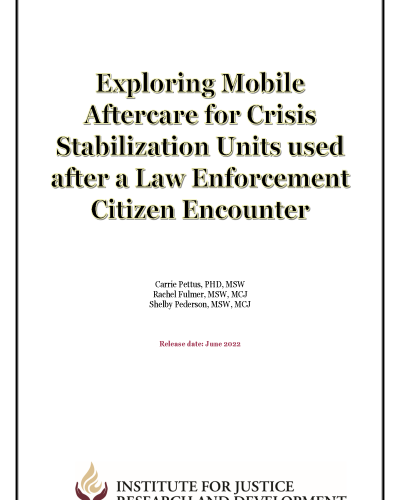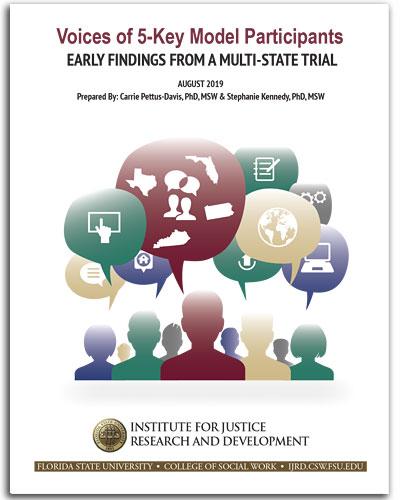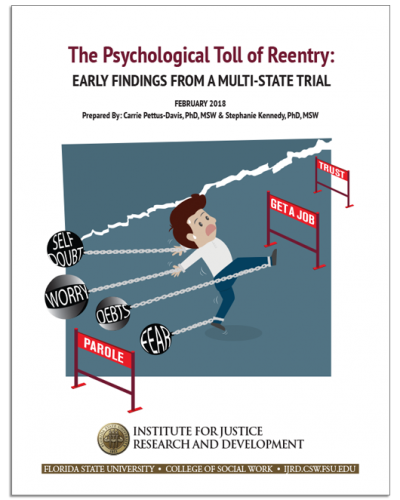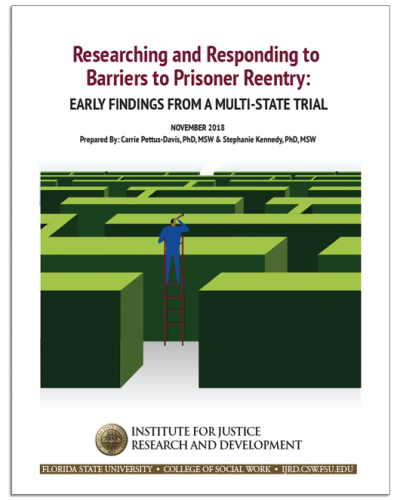
Behavioral health literacy: A new construct to improve outcomes among incarcerated individuals
Published:
| Author: Carrie Pettus, Stephanie Kennedy, Tanya Renn, Stephen Tripodi, Lauren Herod, Danielle Rudes, Faye Taxman
In the United States, nearly 13 million adults are incarcerated in prisons and jails annually with significant negative public health consequences. Incarcerated individuals have disproportionate rates of behavioral health disorders (BHDs); untreated BHD symptoms bring people into incarceration settings and are associated with re-arrest after release.
Category: Incarceration, Mental Health, Reentry, Substance Use

Exploring Mobile Aftercare for Crisis Stabilization Units used after a Law Enforcement Citizen Encounter
Published:
| Author: Carrie Pettus, Rachel Fulmer, Shelby Pederson
As public receiving facilities, CSUs offer a critical non-refusal option for law enforcement, meaning they are obligated to accept individuals brought under an emergency involuntary psychiatric hold. This CSU policy offers an important alternative to arrest for law enforcement, who often encounter individuals experiencing these types of crises. Research indicates that law enforcement often has repeat contact with individuals experiencing mental health and substance-related crises and that a history of interaction with the criminal justice system is common in the typical CSU patient.
Category: Law Enforcement, Reentry

Study protocol paper for the multisite randomized controlled trial of comprehensive trauma informed reentry services for moderate to high-risk young males releasing from state prisons
Published:
| Author: Carrie Pettus, Tanya Renn, Stephen Tripodi, Sarah Tamburri
This study will provide critical information about how trauma-informed reentry programming impacts traditional reentry outcomes (e.g., recidivism, housing, employment) and identify key mechanisms of action (e.g., reduced impulsivity and aggression). Coping with trauma symptomatology is a largely untapped area of scientific inquiry for criminal justice-involved populations, despite the significant role trauma plays in individuals’ lives. Results advance identification of critical components of trauma-informed reentry interventions for moderate- to high-risk young men.
Category: Trauma, Reentry, Well-Being, Community

The Well-Being Development Model: A Theoretical Model to Improve Outcomes among Criminal Justice System–Involved Individuals
Published:
| Author: Carrie Pettus, Christopher Veeh, Tanya Renn, Stephanie Kennedy
This article proposes a new conceptual framework, the Well-Being Development Model (WBDM), to support the development, implementation, and assessment of innovative reentry interventions designed to increase well-being among the millions of individuals released from prisons and jails each year. In contrast to prominent models guiding reentry services, the WBDM increases incarcerated and formerly incarcerated individuals’ capacity to reach their full potential while addressing common problems and barriers to success.
Category: Well-Being, Reentry

Trauma and Loss During Reentry
Published:
| Author: Carrie Pettus-Davis, Tanya Renn, Stephanie Kennedy
This report presents data about the extremely stressful life events experienced by study participants in the 8 months after they left incarceration and returned home. These stressful life events included losing a loved one to homicide, having been violently assaulted, witnessing violence and death in the home or community, finding out about the death or serious injury of a loved one, being diagnosed with a life-threatening illness, and losing critical resources like housing, employment, income, transportation, and social support.
Category: Reentry, Well-Being, 5-Key Model for Reentry

Going Back to Jail Without Committing a Crime
Published:
| Author: Carrie Pettus-Davis, Stephanie Kennedy
This report presents data on reasons other than criminal behavior that 5-Key Model study participants report they were re-arrested.
Category: Reentry, Well-Being, 5-Key Model for Reentry

When Death Follows Release
Published:
| Author: Carrie Pettus-Davis, Stephanie Kennedy
This report highlights the reentry period - leaving incarceration and returning home - as the highest risk time for death in a formerly incarcerated individuals’ life. The purpose of this report is to explore the deaths that occur during the reentry period from several different vantage points.
Category: Reentry, Well-Being, 5-Key Model for Reentry

Voices of 5-Key Model Participants
Published:
| Author: Carrie Pettus-Davis, Stephanie Kennedy
This report contains interviews from four study participants involved in the 5-Key Model. The purpose of this report is to highlight the stories of participants in the 5-Key Model to provide a personal window into the experiences of those recently released from prisons. The interview explored participants’ lives and families, successes and challenges, and solicited advice for effectively helping individuals leaving incarceration.
Category: Reentry, Well-Being, 5-Key Model for Reentry

Pathways to Recidivism for women released from prison:A Mediated model
Published:
| Author: Stephen Tripodi, Carrie Pettus-Davis, Kimberly Bender, Michael Fitzgerald, Tanya Renn, Stephanie Kennedy
Findings showed no direct relationship between childhood trauma and reincarceration for women in the sample, although there was a significant mediated relationship from childhood trauma to depression to reincarceration. Results suggest the importance of addressing incarcerated women’s trauma before release, assessing for depression, and using empirically-supported interventions to treat depression when applicable.
Category: Incarcerated Women, Reentry

Accelerating Science Using the Research-to-Practice Feedback Loop
Published:
| Author: Carrie Pettus-Davis, Stephanie Kennedy
The report details the implementation of a Research-to-Practice Feedback Loop and how this Feedback Loop has been used to overcome challenges and adapt both the 5-Key Model intervention and how the intervention is delivered to individuals as they release from prison. The Feedback Loop provides space for practitioners, study participants, and researchers to identify areas for improvement and formalizes a process to ensure that any changes made are consistent with the original model, acceptable to all parties, and implemented fairly across all study sites.
Category: Reentry, Well-Being, 5-Key Model for Reentry

The Psychological Toll of Reentry
Published:
| Author: Carrie Pettus-Davis, Stephanie Kennedy
The struggle of reentry is common across hundreds of study participants and the reentry experience has a wide range of ripple out consequences for individual, family, and community well-being, and it intersects with the potential for future criminal behavior and public safety.
Category: Reentry, Well-Being, 5-Key Model for Reentry

Researching and Responding to Barriers to Prisoner Reentry
Published:
| Author: Carrie Pettus-Davis, Stephanie Kennedy
This report describes the inner workings and early discoveries of participants and researchers in a groundbreaking longitudinal study currently occurring in four states, 50 prisons, 12 urban and rural counties with more than 1800 people enrolled since May 2018. The study, officially titled A Multisite Randomized Controlled Trial of the 5 Key Model for Reentry, is research that is occurring as a part of a larger initiative referred to as the Safe Streets and Second Chances initiative.
Category: Reentry, Well-Being, 5-Key Model for Reentry

The Intersectional Effects of Race and Gender on Time to Reincarceration
Published:
| Author: Katie Ropes Berry, Stephanie Kennedy, Margaret Lloyd, Christopher Veeh, Stephen Tripodi
People of color are overly incarcerated and reincarcerated after release. In an 8-year analysis of more than 21,000 individuals leaving state prisons, Black men were incarcerated more often and more quickly when compared to all other groups. However, with two exceptions (age at intake and marital status), Black men had lower risk scores on most variables when compared to other members of the sample. The interactions found were a potent predictor of time to reincarceration, even when controlling for a range of identified risk factors.
Category: Reentry, Recidivism, Racial and Gender BIas

The Relationship Between Severe Mental Disorders and Recidivism in a Sample of Women Released from Prison.
Published:
| Author: Erin A. King, Stephen Tripodi, Christopher Veeh
Women are one of the fastest growing sectors of the prison population, and have different pathways into prison and differing needs during the reentry process when compared to men. Women report higher levels of mental health problems overall, and report more severe symptomatology. The current study focuses on the role of severe mental disorders (SMDs) for 2,311 women released from prison and how SMDs relate to recidivism. Women diagnosed with SMDs were 16% more likely to have recidivated at eight years post-release compared with women who were not diagnosed with an SMD (p < .05).
Category: Reentry, Recidivism, Mental Health, Incarcerated Women

Proposing a population-specific intervention approach to treat trauma among men during and after incarceration.
Published:
| Author: Carrie Pettus-Davis, Tanya Renn, Jeffrey Lacasse, Robert Motley
A significant treatment gap exists for incarcerated men with lifetime traumatic experiences. A small research base for trauma interventions for incarcerated women is emerging, but incarcerated men have largely been ignored. Men comprise 90% of the incarcerated population and are at the greatest risk to be rearrested for a new crime after release.

